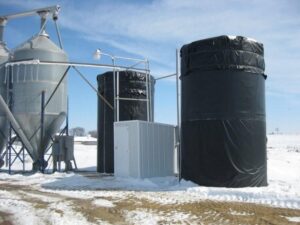Introduction to Underfloor Heating systems
Underfloor heating systems have revolutionized the way we approach indoor heating, offering a modern and efficient alternative to traditional heating methods. Unlike conventional radiators or forced-air systems, underfloor heating distributes heat evenly across the entire floor space, providing a comfortable and consistent warmth throughout the room. This innovative heating solution has gained popularity in both residential and commercial settings, offering numerous benefits in terms of comfort, energy efficiency, and design flexibility. Visit our SVR Trace to see the best cost efficient products.
One of the key features of underfloor heating is its ability to deliver warmth from the ground up, eliminating the need for bulky radiators or ductwork. This not only frees up valuable wall and floor space but also creates a more aesthetically pleasing environment. With underfloor heating, furniture placement becomes more flexible, allowing for greater design freedom and room layout options. Check our shop for the best heating cables and order now!
There are two main types of Underfloor heating systems: electric and water-based. Electric underfloor heating utilizes electric cables or heating mats installed beneath the floor surface, while water-based systems involve circulating warm water through a network of pipes laid within the floor structure. Both systems have their advantages and can be tailored to suit different heating requirements and budgets. Contact us for more data!
The installation process for underfloor heating typically involves careful planning and coordination with architects, builders, and heating engineers. Depending on the type of system and the existing floor construction, installation may vary in complexity. However, with proper planning and professional installation, underfloor heating can be seamlessly integrated into new construction projects or retrofitted into existing buildings.
In addition to providing exceptional comfort, underfloor heating is also renowned for its energy efficiency. By heating the floor surface directly, underfloor heating reduces heat loss and energy consumption compared to traditional heating methods. This not only translates to lower utility bills but also contributes to a more sustainable and environmentally friendly heating solution.
In summary, underfloor heating represents a modern approach to indoor heating, offering unparalleled comfort, energy efficiency, and design flexibility. Whether you’re building a new home or upgrading an existing heating system, underfloor heating is worth considering for its numerous benefits and long-term value.
Visit our blog page for the newest content about industrial products and household products in the field of the radiant floor heating cables!
- What are the Types of Underfloor Heating Systems ?
- What are the Benefits of Underfloor Heating ?
- How to understand Underfloor Heating Products ?
- How is the Installation Process ?
- What are the Maintenance Tips for Underfloor Heating Systems ?
- How is the Cost Considerations ?
- How is the Compatibility with Different Floorings ?
- What are the Innovations in Underfloor Heating Technology ?
- What is the Environmental Impact of this type of heating?
These are the questions that will be answered in this article. So lets continue!
Table of Contents
- Introduction to Underfloor Heating
- Types of Underfloor Heating Systems
- Benefits of Underfloor Heating
- Understanding Underfloor Heating Products
- Installation Process
- Maintenance Tips for Underfloor Heating Systems
- Cost Considerations
- Compatibility with Different Floorings
- Innovations in Underfloor Heating Technology
- Environmental Impact
- FAQs
- Conclusion
Types of Underfloor Heating Systems
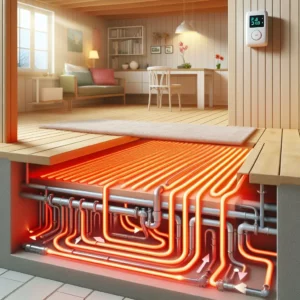
Underfloor heating systems offer a modern and efficient way to heat indoor spaces, providing comfort and energy efficiency. There are two main types of Underfloor heating systems: electric and water-based.
Electric Underfloor heating systems utilize electric cables or heating mats installed beneath the floor surface to generate warmth. These systems are typically easier and quicker to install, making them ideal for retrofitting into existing buildings or smaller spaces. Electric underfloor heating is also suitable for individual room heating or as a supplementary heating solution. It offers precise temperature control, allowing users to adjust the heat output according to their preferences. However, electric underfloor heating may have higher operating costs compared to water-based systems, particularly in areas with expensive electricity tariffs. (Cost efficiency matters!)
Water-based Underfloor heating systems, also known as hydronic underfloor heating, involve circulating warm water through a network of pipes laid within the floor structure. This type of system is commonly integrated into new construction projects or larger buildings, where it can efficiently heat multiple rooms or even entire floors. Water-based underfloor heating provides excellent thermal comfort and can be powered by various heat sources, including boilers, heat pumps, or solar panels. Although the installation process for water-based systems is more complex and time-consuming compared to electric systems, they offer lower operating costs in the long run, especially when paired with renewable energy sources.
Both electric and water-based Underfloor heating systems have their advantages and can be tailored to suit different heating requirements and budgets. Whether you prioritize quick installation, individual room control, or long-term energy savings, underfloor heating provides a versatile and efficient heating solution for modern living spaces.
Benefits of Underfloor Heating systems
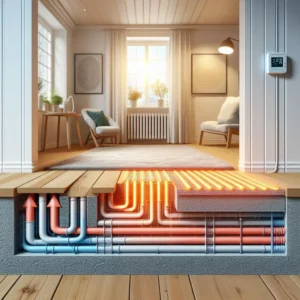
Underfloor heating systems offers numerous benefits that make it a popular choice for heating indoor spaces, whether in residential homes or commercial buildings. Here are some of the key advantages of underfloor heating:
1. Enhanced Comfort:
Underfloor heating systems distributes heat evenly across the entire floor surface, creating a consistent and comfortable warmth throughout the room. Unlike traditional heating systems that rely on radiators or forced air, underfloor heating eliminates cold spots and drafts, providing a more pleasant indoor environment.
2. Energy Efficiency:
Underfloor heating operates at lower temperatures compared to conventional heating methods, resulting in reduced energy consumption and lower utility bills. By heating the floor surface directly, radiant underfloor heating minimizes heat loss and maximizes energy efficiency, especially when paired with insulation and programmable thermostats.
3. Design Flexibility:
Underfloor heating eliminates the need for bulky radiators or ductwork, freeing up valuable wall and floor space for furniture placement and interior design. With underfloor heating, homeowners and designers have greater flexibility in room layout and aesthetics, allowing for seamless integration with various flooring materials and styles.
4. Health Benefits:
Underfloor heating systems helps to maintain a more hygienic indoor environment by reducing dust circulation and minimizing the growth of allergens such as dust mites and mold. Unlike radiators, which can attract dust and create hotspots, underfloor heating promotes cleaner air and a healthier living environment. Health benefits of underfloor heating .
5. Quiet Operation:
Underfloor heating operates silently, without the noise and disturbances associated with traditional heating systems. This makes it ideal for bedrooms, nurseries, and other areas where peace and quiet are desired.
Overall, underfloor heating offers a range of benefits including enhanced comfort, energy efficiency, design flexibility, and improved indoor air quality, making it an attractive heating solution for modern homes and buildings.
Understanding Underfloor Heating Products
Underfloor heating products encompass a variety of components and systems designed to provide efficient and comfortable heating solutions for residential and commercial spaces. These products range from heating cables and mats to control systems and accessories, each playing a crucial role in the overall performance and functionality of the underfloor heating system. Our new products: (underfloor heating straps, underfloor heating film)
Heating cables are one of the primary components of electric Underfloor heating systems. These cables, typically made of durable materials such as copper or alloy, are installed beneath the floor surface to generate heat. They come in various lengths and power ratings to accommodate different room sizes and heating requirements.
Heating mats offer a convenient and efficient solution for electric underfloor heating installations. These pre-assembled mats consist of heating cables attached to a flexible mesh backing, making them easy to lay out and install over the floor surface. Heating mats are particularly suitable for larger areas or rooms with irregular shapes, as they can be trimmed and adjusted to fit the space accordingly.
Control systems play a crucial role in regulating the operation of Underfloor heating systems, allowing users to adjust the temperature and schedule heating cycles according to their preferences. Programmable thermostats, smart heating controls, and zoning systems are common features found in underfloor heating control systems, offering convenience, energy savings, and customization options.
In addition to heating cables, mats, and control systems, underfloor heating products also include insulation materials, floor sensors, and installation accessories such as fixing tape and clips. These components work together to ensure optimal performance, energy efficiency, and longevity of the Underfloor heating systems.
Understanding the different Underfloor heating systems products available on the market is essential for selecting the right components and designing a system that meets the specific heating needs and requirements of the space. Whether you’re planning a new installation or retrofitting an existing building, consulting with a qualified heating engineer or contractor can help you navigate the options and make informed decisions regarding underfloor heating products.
Installation Process

The installation process of Underfloor heating systems involves several steps to ensure proper integration and functionality. While the specific procedures may vary depending on the type of system and the existing floor structure, the following outline provides a general overview of the installation process:
1. Planning and Design:
Before beginning the installation, careful planning and design are essential to determine the layout, home heating industry requirements, and compatibility with the existing floor structure. Factors such as room size, insulation, flooring type, and heat output requirements should be considered during this phase.
2. Subfloor Preparation:
The subfloor must be clean, level, and free of any debris or obstructions before installing the Underfloor heating systems. Depending on the type of system and flooring material, additional preparation such as insulation or screeding may be required to optimize heat distribution and efficiency.
3. Installation of Heating Elements:
For electric Underfloor heating systems, heating cables or mats are laid out and secured to the subfloor according to the predetermined layout. Care should be taken to maintain proper spacing and coverage to ensure uniform heat distribution across the floor surface.
4. Connection and Testing:
Once the heating elements are installed, they are connected to the power supply and control system. Before covering the heating elements with flooring material, the system should be thoroughly tested to ensure proper functionality and safety.
5. Installation of Flooring Material:
After the Underfloor heating systems have been tested and approved, the final step is to install the chosen flooring material over the heating elements. Whether it’s tiles, laminate, wood, or carpet, the flooring material should be compatible with underfloor heating and installed according to manufacturer recommendations.
6. Commissioning and Handover:
Once the installation is complete, the Underfloor heating systems should be commissioned by a qualified engineer or installer to verify performance and functionality. The homeowner or building occupant should also be provided with instructions on how to operate and maintain the Underfloor heating systems effectively.
By following these steps and working with experienced professionals, the installation process of Underfloor heating systems can be completed efficiently and successfully, providing long-lasting comfort and energy efficiency for the indoor environment. A brief history of home heating.
Maintenance Tips for Underfloor Heating Systems
Underfloor heating systems are generally low-maintenance compared to traditional heating systems, but regular upkeep is essential to ensure optimal performance and longevity. Here are some maintenance tips to keep your Underfloor heating systems in top condition:(new tips for maintenance)
1. Regular Cleaning:
Keep the floor surface clean and free of debris to prevent any obstructions that could impede heat distribution. Vacuum or sweep the floor regularly, especially in areas with high foot traffic.
2. Inspect for Damage:
Periodically inspect the floor surface and surrounding areas for any signs of damage or wear, such as cracks, loose tiles, or damaged insulation. Address any issues promptly to prevent further damage to the Underfloor heating systems.
3. Check Thermostat Settings:
Monitor the thermostat settings and adjust the temperature as needed to maintain a comfortable indoor environment. Avoid constantly changing the temperature settings, as this can put unnecessary strain on the system.
4. Bleed Radiators (for water-based systems):
If you have water-based Underfloor heating systems connected to radiators, bleeding the radiators periodically can help remove any trapped air, ensuring efficient heat distribution throughout the system.
5. Test Heating Zones:
If your Underfloor heating systems are divided into heating zones, test each zone individually to verify that they are heating properly. This can help identify any issues with individual zones and ensure even heat distribution throughout the space. Hazard zones in the underfloor heating industry.
6. Schedule Professional Maintenance:
Consider scheduling regular maintenance checks with a qualified heating engineer or technician to inspect the Underfloor heating systems and perform any necessary repairs or adjustments. Professional maintenance can help identify potential issues early on and prevent costly repairs in the future.
By following these maintenance tips, you can ensure that your Underfloor heating systems operate efficiently and effectively, providing consistent warmth and comfort for years to come.
Cost Considerations
When considering underfloor heating for your home or commercial space, it’s essential to factor in both the initial investment and long-term operating costs. Here are some cost considerations to keep in mind:
1. Installation Costs:
The upfront cost of installing Underfloor heating systems can vary depending on factors such as the type of system, size of the area to be heated, and complexity of the installation. Electric Underfloor heating systems are generally cheaper to install compared to water-based systems, which may require more extensive labor and materials.
2. Operating Costs:
While Underfloor heating systems can offer energy savings compared to traditional heating methods, it’s important to consider the ongoing operating costs. Electric Underfloor heating systems may have higher electricity usage and therefore higher operating costs, especially in areas with expensive electricity tariffs. Water-based systems, on the other hand, can be more energy-efficient, particularly when paired with renewable energy sources such as heat pumps or solar panels.
3. Maintenance Costs:
Underfloor heating systems typically require minimal maintenance compared to traditional heating systems. However, it’s still important to budget for occasional maintenance checks and any potential repairs that may arise over time.
By considering these cost factors upfront, you can make informed decisions about the type of Underfloor heating systems that best fits your budget and heating needs. (heat tracing cables)
Compatibility with Different Floorings

Underfloor heating systems offer versatility in terms of compatibility with various types of flooring materials, allowing homeowners and designers to achieve both aesthetic and functional goals. Understanding the compatibility of different flooring types with Underfloor heating systems are crucial for ensuring optimal performance and efficiency. Here’s a guide to the compatibility of common flooring materials with underfloor heating:
1. Tile and Stone:
Tile and stone flooring are excellent conductors of heat, making them ideal choices for use with Underfloor heating systems. These materials allow heat to transfer efficiently from the heating elements to the surface, providing comfortable warmth throughout the room.
2. Laminate and Engineered Wood:
Laminate and engineered wood flooring are suitable for use with underfloor heating, but it’s essential to choose products specifically designed for compatibility with radiant heat. Look for flooring with a low thermal resistance rating to ensure efficient heat transfer and prevent damage to the floorboards.
3. Solid Wood:
Solid wood flooring can be used with Underfloor heating systems, but it’s important to select a species of wood with stable thermal properties to minimize the risk of warping or cracking. Thicker boards may also be preferable as they provide better heat conductivity.
4. Vinyl and Linoleum:
Vinyl and linoleum flooring are compatible with Underfloor heating systems and offer excellent heat distribution properties. However, it’s essential to choose products with a suitable thickness and thermal conductivity to ensure efficient heat transfer.
5. Carpet:
Carpet can be used with Underfloor heating systems, but it’s important to select a carpet with a low thermal resistance rating to allow heat to penetrate through to the surface. Additionally, choosing a thinner carpet with a dense pile will facilitate better heat transfer.
By considering the compatibility of different flooring materials with underfloor heating, homeowners and designers can create comfortable and efficient heating solutions that complement their desired aesthetic and functional requirements. Consulting with flooring and heating professionals can help ensure the best results for your specific project. This also useful in household underfloor heating.
Innovations in Underfloor Heating Technology products
In recent years, there have been significant advancements in underfloor heating technology, leading to more efficient, convenient, and sustainable heating solutions for residential and commercial spaces. These innovations encompass various aspects of Underfloor heating systems, from heating elements to control systems and energy management. Here are some notable innovations in underfloor heating technology:
1. Smart Thermostats:
The integration of smart thermostats into Underfloor heating systems allows for precise temperature control and remote management via smartphones or other smart devices. Smart thermostats offer features such as programmable schedules, energy usage monitoring, and compatibility with voice assistants, enhancing convenience and energy efficiency.
2. Thin-Film Heating Elements:
Thin-film heating elements are ultra-thin, flexible panels that can be installed directly under floor coverings such as laminate, engineered wood, and vinyl. These innovative heating elements offer quick response times and efficient heat distribution, making them ideal for retrofitting existing buildings or installations with limited floor height.
3. Energy-Efficient Heat Pumps:
Heat pumps, particularly air-source and ground-source heat pumps, have become popular choices for powering water-based Underfloor heating systems. These energy-efficient heat pumps extract heat from the surrounding environment and transfer it into the underfloor heating system, providing sustainable heating solutions with lower operating costs and reduced carbon emissions.
4. Hydronic Mixing Systems:
Advanced hydronic mixing systems optimize the performance of water-based Underfloor heating systems by precisely blending hot water from the heat source with cooler return water from the heating circuit. Underfloor heating systems ensure consistent water temperatures throughout the system, maximizing energy efficiency and comfort.
5. Renewable Energy Integration:
Underfloor heating systems are increasingly being integrated with renewable energy sources such as solar panels, geothermal heat pumps, and biomass boilers. This integration reduces reliance on fossil fuels, lowers carbon emissions, and enhances the sustainability of Underfloor heating systems.
These innovations in underfloor heating technology are driving the evolution of heating solutions towards greater efficiency, comfort, and environmental sustainability. As technology continues to advance, Underfloor heating systems will likely become even more intelligent, adaptable, and energy-efficient, meeting the heating needs of modern buildings while minimizing their environmental impact.
Environmental Impact
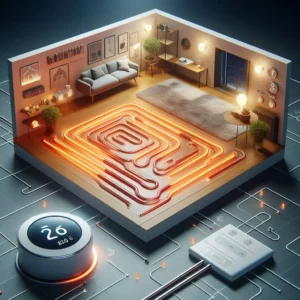
Underfloor heating systems offer several environmental benefits compared to traditional heating methods, contributing to reduced carbon emissions and energy consumption. One of the primary environmental advantages of underfloor heating is its energy efficiency. By distributing heat evenly across the floor surface, Underfloor heating systems operate at lower temperatures compared to traditional radiators or forced-air systems, resulting in reduced energy consumption and lower greenhouse gas emissions.
Furthermore, Underfloor heating systems can be powered by renewable energy sources such as solar panels, geothermal heat pumps, or biomass boilers, further reducing their environmental impact. By utilizing clean and sustainable energy sources, Underfloor heating systems help decrease reliance on fossil fuels and mitigate the environmental effects of energy production.
Additionally, Underfloor heating systems can improve indoor air quality by reducing the circulation of allergens such as dust mites and mold, promoting a healthier living environment. This can have positive implications for respiratory health and overall well-being.
Overall, Underfloor heating systems offer an environmentally friendly heating solution that prioritizes energy efficiency, sustainability, and indoor air quality, contributing to a greener and healthier planet.
FAQs
1. What is underfloor heating?
Underfloor heating systems are a heating system installed beneath the floor surface to provide warmth to indoor spaces. It involves either electric heating cables/mats or water-filled pipes installed within the floor structure.
2. How does underfloor heating work?
Underfloor heating systems work by radiating heat from the floor surface, warming the room from the ground up. Electric systems use resistance heating to generate warmth, while water-based systems circulate warm water through the pipes to provide heat.
3. Are Underfloor heating systems suitable for all types of flooring?
Underfloor heating is compatible with most types of flooring, including tile, stone, laminate, engineered wood, carpet, and vinyl. However, it’s essential to choose flooring materials with suitable thermal conductivity for optimal performance.
4. Can underfloor heating be installed in existing buildings?
Yes, underfloor heating can be retrofitted into existing buildings, although the installation process may be more complex compared to new construction. Electric systems are typically easier to install in retrofit projects due to their thinner profile and flexibility.
5. How energy-efficient is underfloor heating?
Underfloor heating systems are generally more energy-efficient than traditional heating methods due to their ability to distribute heat evenly and operate at lower temperatures. Water-based systems, especially when powered by renewable energy sources, offer significant energy savings.
6. Are Underfloor heating systems expensive to install?
The cost of installing Underfloor heating systems depends on factors such as the type of system, the size of the area to be heated, and the complexity of the installation. While the upfront costs may be higher than traditional heating systems, underfloor heating can provide long-term energy savings and increased comfort.
7. How long does it take to install underfloor heating?
The installation time for underfloor heating varies depending on factors such as the size of the area, the type of system, and the complexity of the installation. Electric systems are typically quicker to install compared to water-based systems.
8. Can I control the temperature of underfloor heating?
Yes, Underfloor heating systems can be controlled using thermostats or smart heating controls, allowing users to adjust the temperature according to their preferences. Programmable thermostats offer scheduling options for increased convenience and energy savings.
9. Is underfloor heating suitable for bathrooms?
Yes, underfloor heating is particularly well-suited for bathrooms, providing comfortable warmth underfoot and helping to prevent cold floors. Electric systems are commonly used in bathrooms due to their quick response times and suitability for smaller spaces.
10. Are there any maintenance requirements for underfloor heating?
Underfloor heating systems generally require minimal maintenance. Regular cleaning and occasional inspections are recommended to ensure optimal performance. Water-based systems may require periodic checks for leaks or air pockets in the pipes.
conclusion
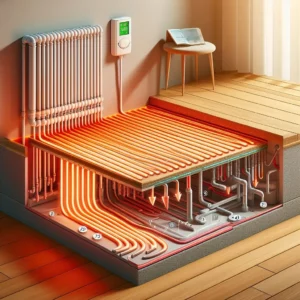
In conclusion, Underfloor heating systems offer a modern, efficient, and comfortable solution for heating indoor spaces. With their ability to distribute heat evenly across the floor surface, Underfloor heating systems provide consistent warmth from the ground up, eliminating cold spots and drafts commonly associated with traditional heating methods. Whether powered by electricity or water, Underfloor heating systems offer versatility in terms of compatibility with various types of flooring materials, allowing homeowners and designers to achieve both aesthetic and functional goals also for open space heating.
Moreover, Underfloor heating systems contribute to energy efficiency and sustainability by operating at lower temperatures compared to traditional radiators or forced-air systems. By reducing energy consumption and reliance on fossil fuels, Underfloor heating systems help lower carbon emissions and minimize environmental impact. Additionally, advancements in technology, such as smart thermostats and renewable energy integration, further enhance the energy efficiency and convenience of Underfloor heating systems.
Furthermore, Underfloor heating systems offer flexibility in installation, suitable for both new construction projects and retrofitting existing buildings. While the initial investment may be higher compared to traditional heating systems, the long-term benefits in terms of energy savings, comfort, and indoor air quality make underfloor heating a worthwhile investment.
Overall, Underfloor heating systems represent a sustainable, cost-effective, and environmentally friendly heating solution for modern homes and buildings. As technology continues to evolve, Underfloor heating systems will likely become even more efficient, intelligent, and adaptable, meeting the heating needs of future generations while promoting a greener and healthier planet.




